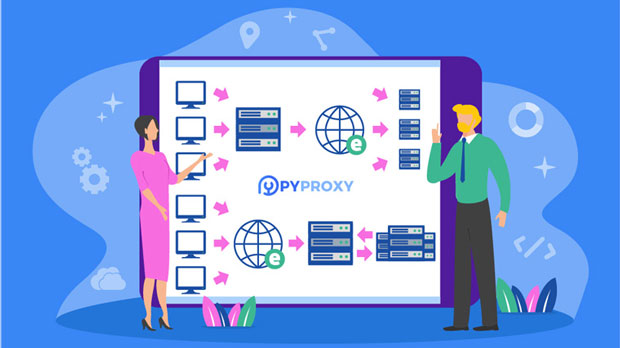How does the encryption feature of Advanced SOCKS5 Agent improve data security?
In an increasingly interconnected world, ensuring data security has become a top priority for both individuals and organizations. Advanced socks5 proxies, especially those equipped with robust encryption features, offer a significant improvement in protecting online privacy and securing data transmissions. By acting as an intermediary between a user and the internet, SOCKS5 proxies mask the user's real IP address and route traffic through a remote server. When combined with encryption, this additional layer of security helps prevent unauthorized access, data leaks, and cyberattacks. In this article, we will explore how advanced SOCKS5 proxies leverage encryption to enhance data security, how it works in practice, and why it is essential for modern online activities. Understanding SOCKS5 Proxies and Their Role in Data SecuritySOCKS5 is the latest and most advanced version of the SOCKS protocol, designed to support a wide range of network protocols beyond just HTTP or HTTPS. Unlike its predecessors, SOCKS5 allows for flexible routing of data traffic and provides significant improvements in privacy and security. It functions as an intermediary server that facilitates communication between a user’s device and the internet, without disclosing the user’s actual IP address. By doing so, SOCKS5 proxies make it significantly harder for third parties, such as hackers or malicious websites, to trace or monitor a user’s activities. This becomes particularly useful when a user is engaging in sensitive online activities, such as accessing confidential business information, conducting secure financial transactions, or simply wanting to remain anonymous while browsing.However, the basic SOCKS5 protocol does not offer encryption on its own. Without encryption, the data being transmitted between the user and the proxy server can be intercepted and exposed by malicious actors. This is where advanced SOCKS5 proxies, equipped with encryption capabilities, come into play. The Role of Encryption in Advanced SOCKS5 ProxiesEncryption is the cornerstone of modern cybersecurity. It involves converting data into a coded format that can only be decoded by authorized parties who possess the correct decryption key. By adding encryption to SOCKS5 proxies, the communication between the user and the proxy server becomes significantly more secure. Let’s delve into how encryption works in conjunction with SOCKS5 proxies and why it’s critical for data security.1. Preventing Eavesdropping and Man-in-the-Middle Attacks One of the primary benefits of encryption is its ability to protect data from eavesdropping. Without encryption, data being transmitted over the internet is vulnerable to interception by hackers or other malicious entities. These attackers could potentially steal sensitive information, such as login credentials, personal identification, or financial details. With advanced encryption protocols like AES (Advanced Encryption Standard) or TLS (Transport Layer Security) integrated into SOCKS5 proxies, even if data is intercepted, it remains unreadable without the correct decryption key. This prevents hackers from gaining access to private communications or sensitive information. Encryption ensures that data remains secure even in the event of a man-in-the-middle attack, where an attacker tries to intercept and alter the communication between the user and the server.2. Securing Online Communications Many online activities require secure communication channels, such as online banking, accessing corporate networks remotely, or communicating through private messaging platforms. These activities can be compromised if data is sent unencrypted over unsecured channels. Using an encrypted socks5 proxy ensures that all communications between the user and the internet are encrypted, preventing unauthorized access or interception. For example, when an employee accesses a corporate network remotely, using an unencrypted connection could expose sensitive corporate data to malicious actors. By using an encrypted SOCKS5 proxy, the organization can ensure that all sensitive data remains protected during transmission.3. Data Integrity and Protection from Tampering Encryption not only ensures that data is unreadable to unauthorized parties but also protects the integrity of the data. Advanced encryption methods like AES come with built-in mechanisms for ensuring that the data is not altered in transit. This protection against tampering is critical for maintaining the authenticity and trustworthiness of the information being exchanged. In a typical unencrypted connection, a hacker could potentially intercept data packets, modify them, and then forward the altered packets to the intended recipient, leading to data corruption or malicious attacks. However, encrypted SOCKS5 proxies include checksums and integrity verifications to ensure that any alteration of the data will be detected, preventing tampered data from reaching its destination.How Advanced SOCKS5 Proxies Address Common Security ConcernsAdvanced SOCKS5 proxies with encryption capabilities offer an added layer of protection against several common online security threats. Let’s explore some of the key concerns they address.1. Protection from DNS Leaks When a user connects to a website, their device usually sends a Domain Name System (DNS) request to resolve the website’s IP address. Without proper protection, these DNS requests can be intercepted and reveal a user’s browsing history or location, even when using a proxy. Advanced SOCKS5 proxies often come with built-in DNS leak protection, ensuring that all DNS requests are routed through the proxy server and remain secure and anonymous.2. Bypassing Geo-Restrictions and Censorship Many users rely on SOCKS5 proxies to bypass geo-restrictions, censorship, or content filtering. In many regions, internet access is monitored or restricted, and using a proxy server helps users access content freely. By encrypting the traffic, SOCKS5 proxies not only help users bypass these restrictions but also shield their browsing activities from local authorities or third-party monitors, adding an extra layer of anonymity and security.3. Protection from Tracking and Profiling Advertisers and malicious websites often track user behavior to create detailed profiles. These profiles are used for targeted ads or more nefarious purposes. Advanced SOCKS5 proxies prevent websites from tracking users by masking their IP addresses and encrypting their traffic. This makes it significantly harder for websites to track users across sessions or gather personal data for profiling purposes.Why Encryption in SOCKS5 Proxies Is Essential for Modern Internet SecurityIn today’s digital world, the importance of online privacy and data security cannot be overstated. Cyberattacks, identity theft, and data breaches are common threats that jeopardize both individual and corporate safety. Advanced SOCKS5 proxies with encryption are a vital tool for mitigating these risks.They provide users with a secure way to browse the internet, access sensitive information, and conduct online transactions without fear of exposure or attack. As cyber threats continue to evolve, the demand for reliable encryption technologies in SOCKS5 proxies will only grow, making them a crucial element in securing online communications and protecting user privacy.By integrating robust encryption methods, advanced SOCKS5 proxies offer a multi-layered approach to data security, combining anonymity, data integrity, and protection from surveillance and hacking attempts. For individuals and organizations concerned about their digital security, using an advanced SOCKS5 proxy with encryption is one of the most effective ways to safeguard their online activities.Conclusion: The Future of Secure Internet UsageAs we move further into the digital age, the need for comprehensive data security solutions will only increase. Advanced SOCKS5 proxies with encryption capabilities offer an effective and reliable solution to protect sensitive data, enhance privacy, and safeguard against a wide array of online threats. Whether for personal browsing, accessing corporate networks, or engaging in secure online transactions, encryption in SOCKS5 proxies plays a crucial role in maintaining a secure and anonymous online presence.In conclusion, understanding how encryption enhances the security of SOCKS5 proxies is essential for anyone looking to ensure the safety of their online activities. By leveraging these advanced tools, users can not only protect their data but also enjoy a more private, secure internet experience.
2024-12-27























































